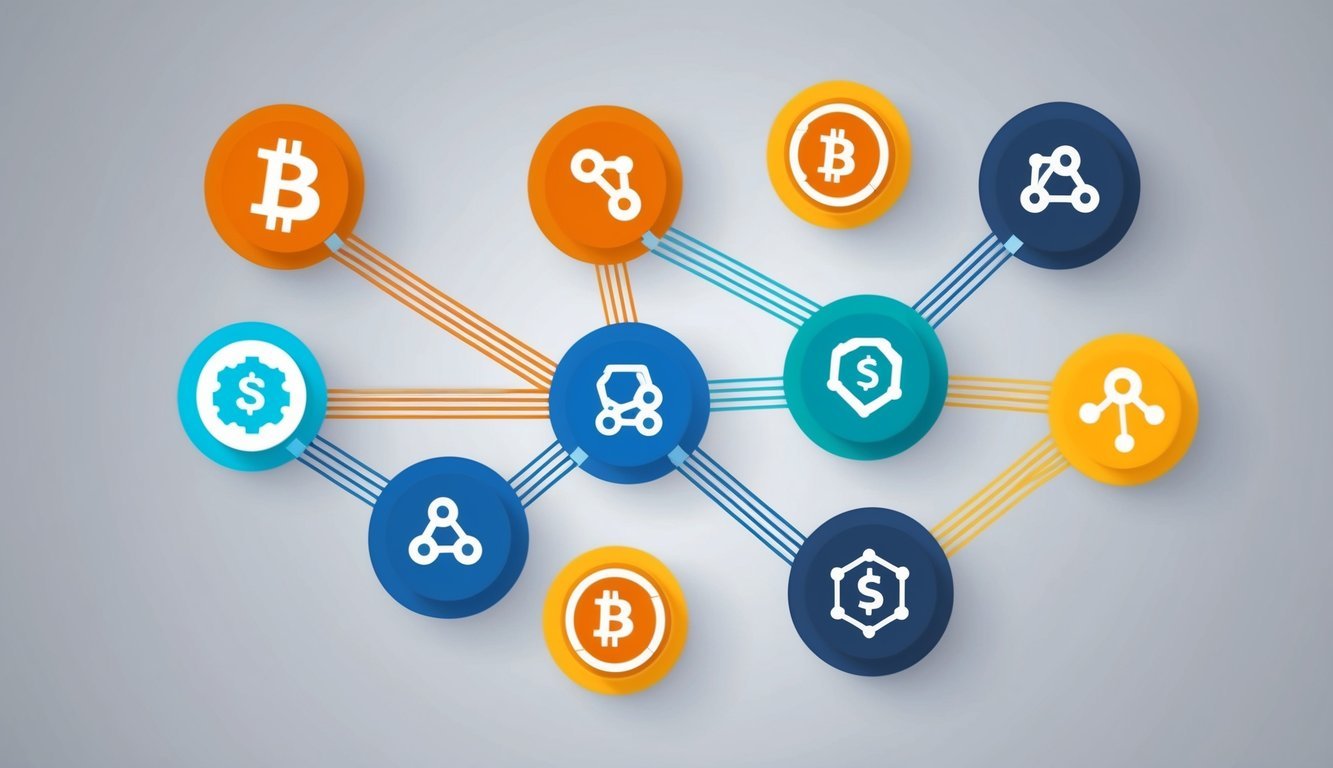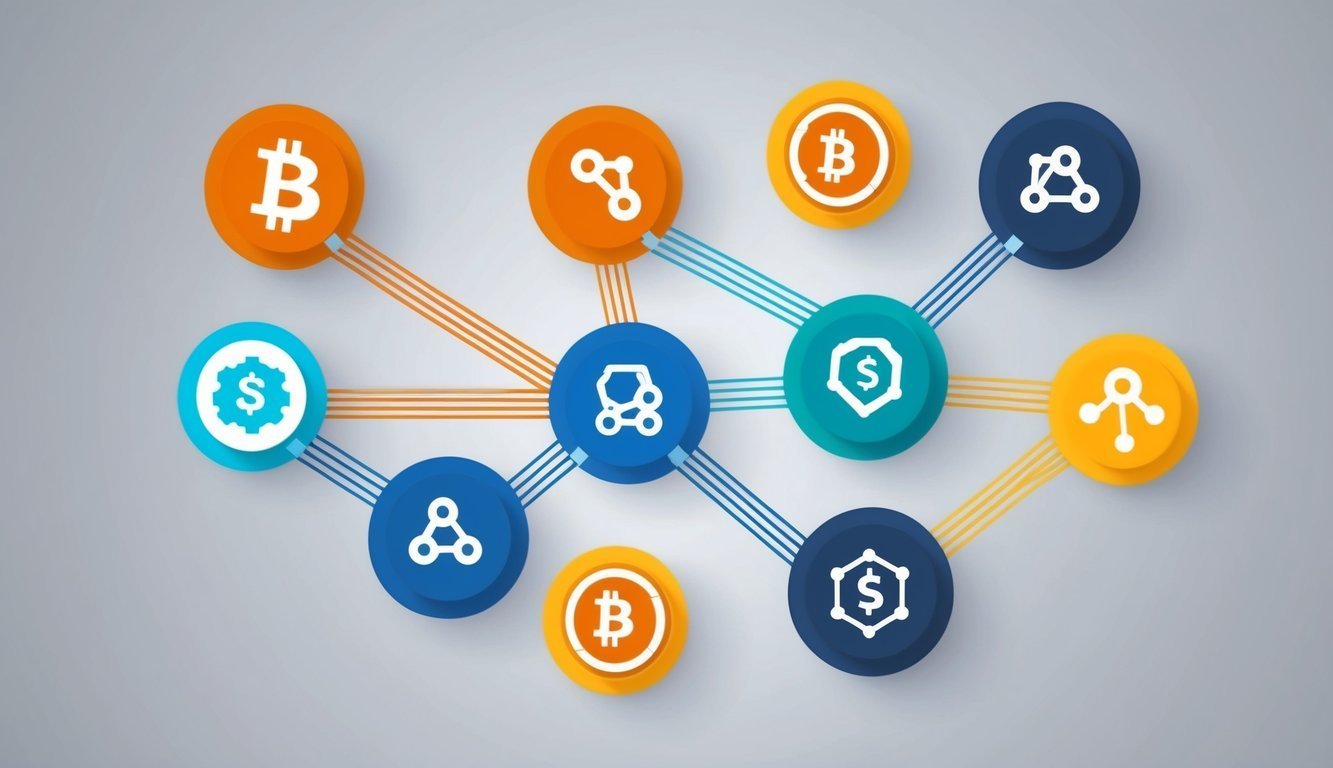Blockchain technology has come a long way since its early days. Now, there’s a new buzzword in town: blockchain interoperability. But what does it mean?
Simply put, different blockchain networks talk to each other and share info.
Blockchain interoperability lets different blockchain systems work together, swap data, and build on each other’s cool features.

Think of blockchain networks as islands. They’re great on their own, but wouldn’t it be awesome if you could easily hop from one to another? That’s what interoperability aims to do. It’s like building bridges between these islands, making it easier for you to move your stuff around.
Why should you care? Well, imagine if your favorite social media apps couldn’t talk to each other. Annoying, right? The same goes for blockchains. With interoperability, you can do more with your digital assets, like swapping tokens between different networks or using one blockchain’s features on another. It’s all about making your blockchain experience smoother and more fun.
Key Takeaways
- Blockchain interoperability connects different networks, enabling seamless data and asset transfer.
- It improves user experience by allowing access to various blockchain features across platforms.
- Interoperability faces challenges but holds potential for a more connected blockchain future.
Fundamentals of Blockchain Technology
Blockchain tech is all about secure, shared data. It uses special methods to keep info safe and lets people work together without a middleman. Let’s dive into the key parts that make blockchain tick.
Defining Blockchain and Its Core Components
Blockchain is like a digital notebook that lots of people can use at once. It’s made up of “blocks” that hold info. Each block links to the one before it, creating a chain.
Here are the main parts:
• Blocks: Where data is stored
• Hash: A unique code for each block
• Peer-to-peer network: How computers talk to each other
• Cryptography: Keeps everything safe and secret
You can think of blockchain as a really secure way to keep track of stuff. It’s great for things like money transfers or keeping records.
The Role of Consensus Mechanisms
Consensus mechanisms are the rules that help everyone agree on what goes in the blockchain. They’re super important for keeping things fair and stopping cheaters.
Popular types include:
- Proof of Work: Computers solve tough math problems
- Proof of Stake: People put up their own coins as a guarantee
These systems make sure everyone plays nice. They help decide who gets to add new info to the blockchain. Without them, it’d be chaos!
Understanding Smart Contracts and DApps
Smart contracts are like robot helpers on the blockchain. They run automatically when certain things happen. No need for a person to check or approve stuff.
DApps, or decentralized applications, use these smart contracts. They’re apps that run on blockchain instead of one company’s computers.
Cool things about DApps:
• They’re open for anyone to use
• No one person or company controls them
• They’re hard to shut down or censor
You might use a DApp for things like voting, trading stuff, or playing games. They’re changing how we think about apps and websites.
Exploring Interoperability in Blockchain
Blockchain interoperability is changing how different networks work together. It aims to connect separate blockchains so they can share info and work as one big system.
Why Interoperability Matters
Interoperability is key for blockchain’s future. It lets you move assets and data between different chains easily. This means you can use your Bitcoin on Ethereum, or swap tokens across networks.
Cross-chain solutions are making blockchains more useful. They help create a connected ecosystem where chains work together instead of alone.
Interoperability also improves:
- User experience: You can use one wallet for many chains
- Security: More chains working together means better safety
- Scalability: Networks can share the load, handling more transactions
Challenges to Achieving Interoperability
Making blockchains work together isn’t easy. Each chain has its own rules and way of doing things. This makes it hard for them to talk to each other.
Some big challenges are:
- Different architectures: Each blockchain is built differently
- Security risks: Connecting chains can create new weak spots
- Speed issues: Moving data between chains can be slow
Technical complexity is a major hurdle. It’s tough to make sure all operations across chains are safe and follow the rules.
Interoperability Solutions Overview
Teams are working on cool ways to connect blockchains. Here are some main types:
- Bridges: These let you move assets between chains
- Sidechains: Smaller chains that connect to bigger ones
- Atomic swaps: Trade tokens across chains without middlemen
New solutions are always popping up. They aim to make cross-chain communication smoother and safer.
Some popular projects are:
- Polkadot: Connects different blockchains
- Cosmos: Creates an “internet of blockchains”
- Chainlink: Helps blockchains talk to the outside world
These tools are making it easier for you to use different blockchains together. They’re building a future where all chains can work as one big team.
Interoperability Mechanisms and Protocols
Blockchain networks are finding new ways to talk to each other. Different tools and methods help blockchains share info and move assets between them. Let’s look at some key ways this happens.
Cross-Chain Technology and Bridges
Blockchain bridges are like highways between different chains. They let you move your coins or tokens from one blockchain to another.
For example, you might use a bridge to send Bitcoin to Ethereum. The bridge locks up your Bitcoin and gives you a matching amount on Ethereum. When you want your Bitcoin back, the bridge burns the Ethereum tokens and releases your original coins.
Some popular bridges include:
- Wormhole
- Polygon Bridge
- Avalanche Bridge
Bridges make it easy to use your assets on different chains. But be careful – bridges can sometimes be hacked, so always use trusted ones.
Oracles and Relays in Data Exchange
Oracles bring real-world data into blockchains. They act like messengers, fetching info from outside and feeding it to smart contracts.
Chainlink is a well-known oracle network. It helps different blockchains get reliable data from the real world.
Relays work a bit differently. They pass messages between blockchains. Think of them as translators that help chains understand each other.
Both oracles and relays are key for chains to share info. They make sure data moves safely and correctly between networks.
Emerging Trends in Interoperability Protocols
New ways to connect blockchains are popping up all the time. Cosmos and Polkadot are two big names in this space.
Cosmos uses something called Inter-Blockchain Communication (IBC). It’s like a universal language for blockchains. With IBC, different chains can easily talk to each other.
Polkadot takes a different approach. It uses parachains – separate blockchains that all connect to a main chain. This setup lets many chains work together smoothly.
Atomic swaps are another cool trend. They let you trade tokens directly between chains without a middleman. It’s like a direct swap between your Bitcoin and someone else’s Ethereum.
Impact and Future of Interoperability

Blockchain interoperability is set to transform the digital landscape. It will make decentralized finance more accessible, bring different blockchain networks together, and pave the way for wider adoption of this technology.
Enhancing Decentralized Finance (DeFi)
Interoperability will give DeFi a big boost. You’ll be able to move your assets between different blockchains easily. This means more options for trading, lending, and borrowing.
Cross-chain DeFi will become a reality. You could stake tokens from one chain to get a loan on another. This flexibility will make DeFi more user-friendly and powerful.
NFTs will also benefit. You might buy an NFT on one chain and use it in a game on another. This will open up new possibilities for digital ownership and creativity.
Fostering Blockchain Ecosystem Collaboration
Different blockchains will work together better. This teamwork will lead to new and exciting decentralized applications.
You’ll see more partnerships between blockchain projects. They’ll share resources and ideas, making the whole ecosystem stronger.
Web3 will become more connected. You won’t have to worry about which blockchain you’re using. Everything will work together smoothly.
Prospects for Mass Adoption and Scalability
As blockchains become more interconnected, they’ll be easier to use. This could lead to more people adopting blockchain technology.
Scalability issues will be less of a problem. When networks can share the load, they can handle more transactions.
You might see blockchain tech in your everyday life. From shopping to voting, it could make many processes faster and more secure.
Big companies and governments might start using blockchain more. This could lead to new services and more efficient systems for you.
Frequently Asked Questions

Blockchain interoperability is a complex topic with many moving parts. Here are some key questions to help you better understand how different networks can work together and the challenges involved.
What are some of the leading blockchain projects that emphasize interoperability?
Polkadot and Cosmos are two major projects focused on blockchain interoperability. They aim to connect different blockchains and allow them to communicate.
Ethereum 2.0 is also working on improving its interoperability features. These projects are building bridges between networks to make data and asset transfers easier.
Can you list prominent cryptocurrencies that are designed for cross-chain interactions?
Some well-known cryptocurrencies built for cross-chain communication include:
- ATOM (Cosmos)
- DOT (Polkadot)
- LINK (Chainlink)
- QNT (Quant)
These tokens play a key role in facilitating transactions and data transfers between different blockchain networks.
What are the common hurdles in achieving blockchain interoperability?
Achieving true interoperability faces several challenges. Technical differences between blockchains can make communication difficult.
Security concerns also arise when connecting separate networks. Ensuring data integrity and preventing attacks across chains is crucial.
Scalability issues can slow down cross-chain transactions. As more blockchains connect, managing the increased data flow becomes more complex.
How do multi-chain networks enhance interoperability among different blockchains?
Multi-chain networks act as connectors between separate blockchains. They create a shared infrastructure that allows different chains to communicate.
These networks often use relay chains or hubs to pass messages and assets between blockchains. This setup makes it easier for users to move their data and tokens across different platforms.
What are the core blockchain protocols critical to understanding interoperability?
Understanding interoperability requires knowledge of several key protocols:
- Cross-chain atomic swaps
- Hashed timelock contracts (HTLCs)
These protocols form the backbone of how different blockchains can securely interact and exchange information.





